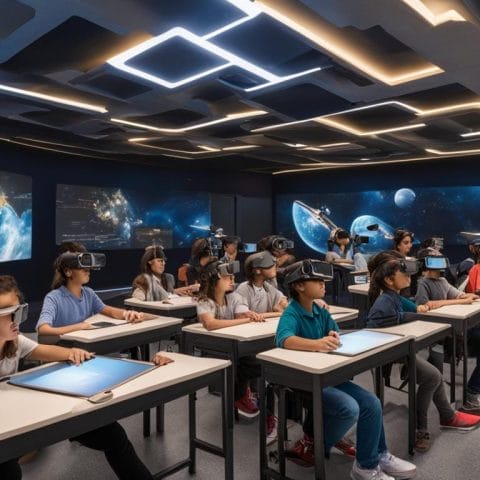AI is changing how we train professionals with virtual simulations. This new method moves old-school training into the future. It creates interactive learning spaces that boost practical skills and keep learners interested.
AI-driven platforms make learning fun with immersive scenarios and interactive eLearning. This way, workers can get hands-on experience without facing real-world dangers.
These simulations give learners a safe space to practice and get feedback right away. AI chatbots are always there to help, answering questions and supporting learning outside of class. AI in education brings many benefits, like interactive materials that fit each learner’s needs. This makes learning better and faster.
Key Takeaways
- AI-driven virtual simulations provide immersive, risk-free environments for developing practical decision-making skills.
- Personalized learning pathways and real-time feedback from AI chatbots enhance learner engagement and skill development.
- Integration of AI in eLearning enables dynamic, adaptive content that caters to diverse learning styles and optimizes learning outcomes.
- AI-powered simulations foster metacognitive awareness and self-regulated learning behaviors, improving knowledge retention.
- The combination of AI technology and human elements in simulations enhances authenticity and effectiveness of training programs.
Core Benefits of AI in Decision-Making Training

As companies move towards digital transformation, AI is changing how we train for decision-making. Virtual and augmented reality, powered by AI, create immersive learning spaces. These spaces help employees learn to make decisions more effectively.
Enhancing Soft Skills through Virtual Environments
AI-driven virtual environments offer personalized, interactive learning. They engage users’ senses and mimic real-world scenarios. This way, employees can practice and improve their soft skills in a safe yet realistic setting.
Creating Realistic Simulation Scenarios
Creating realistic scenarios involves advanced AI programming. These technologies build scenarios with different outcomes based on user actions. This lets users see the effects of their decisions and learn from them.
Integration with Learning Management Systems
AI-powered training can be easily linked to Learning Management Systems (LMS). This lets companies track progress and assess skill growth. It helps tailor learning paths to fit individual needs, improving training effectiveness.
| Key Benefits of AI in Decision-Making Training | Percentage Improvement |
|---|---|
| Increased Employee Engagement | 90% |
| Improved Knowledge Retention | 63% |
| Reduced Training Time | 40% |
| Enhanced Personalization | 75% |
By using AI, companies can improve their decision-making training. This helps build a workforce ready to tackle complex challenges and make strategic decisions.
How Hyperspace Leverages AI Technology
![]()
At Hyperspace, we’re changing how organizations learn to make better decisions with AI. Our virtual simulations use immersive learning and AI to help users improve their critical thinking and problem-solving. This makes learning more effective and fun.
Development of Autonomous AI Avatars
Our AI avatars are key to our learning solutions. These digital characters use machine learning and natural language to talk with users. They change how they act and talk based on what the user does.
Context-Aware Interactions for Realistic Learning
Our AI avatars make learning feel real and engaging. They understand what the user wants and give feedback that fits their needs. This makes learning more like real life, helping users get better at making decisions.
Dynamic Gesture Adaptation to User Actions
We’ve added dynamic gesture adaptation to make our simulations even more real. The AI avatars move and gesture like real people, matching the user’s actions. This makes learning feel more natural and helps users connect better with the scenarios.
With AI, Hyperspace is changing the way we learn to make decisions. Our solutions use the latest technology to create learning experiences that really work. They help individuals and organizations succeed in today’s digital world.
Importance of Self-Paced Learning Journeys
In the world of AI training, self-paced learning is key. It lets learners move at their own speed, making sure they grasp skills well. This method fits different learning styles, making learning more engaging and effective.
Benefits of Customization in Learning Paths
Adaptive learning technologies make self-paced learning personal. Predictive analytics and adaptive decision support systems adjust training based on learner data. This ensures learners are always challenged, boosting their skills and interest.
Progress Tracking and Assessment Features
Tracking and assessing progress is essential in self-paced learning. Interactive simulations and immersive learning environments show how learners are doing. They help pinpoint areas for improvement, making training more focused and efficient.
“The ability to customize learning paths and track progress empowers learners to take ownership of their development, fostering a sense of agency and motivation that is essential for effective skill acquisition.”
Self-paced learning unlocks the full power of a workforce. It gives them the skills to handle today’s business challenges.
Interactive Role-Playing Scenarios
Virtual reality training and interactive simulations are changing how we learn. They create real-life learning environments. Here, users can practice making decisions in a safe space.
Engaging Users in Decision-Making Processes
Virtual reality training and cognitive computing make learning fun. Learners become decision-makers in a virtual world. They face real challenges and make choices that matter.
This hands-on method helps learners remember what they learn. Studies show that virtual reality training boosts confidence by up to 275%.
Collaborating with Peers in Simulated Environments
Immersive learning environments also help teams work together. They can join from anywhere in the world. This makes teamwork and problem-solving better.
These tools give teams a chance to practice together. They improve decision-making and teamwork skills. This is key for success in today’s fast-paced business world.
Using virtual reality, cognitive computing, and simulations, companies can improve decision-making. As AI becomes more common, these tools will help businesses stay ahead.
The Role of Realism in Skill Development
In the world of AI-driven virtual reality training, realism is key. Immersive learning environments that look and feel like real life are vital. They help develop critical decision-making skills. By making virtual reality training experiences engaging, organizations can link classroom learning to real-world use.
Strategies for Immersive Learning Experiences
Companies use advanced tech like virtual reality and augmented reality to boost realism. These immersive learning environments engage all senses, from sight and sound to touch and smell. This makes the interactive simulations experience real.
- VR headsets and AR devices add to the feeling of being there
- High-fidelity graphics create depth and spatial awareness
- Realistic audio and environmental sounds enhance the sensory experience
Utilizing Environmental Controls for Enhanced Engagement
Cognitive computing lets trainers change virtual settings for more realism and engagement. They can set up different scenarios, from emergencies to customer service. This helps trainees practice decision-making in a safe space.
- Customizable virtual environments meet specific training needs
- Adaptive AI-driven responses make the experience fluid and responsive
- Varied learning opportunities expose trainees to many realistic challenges
By focusing on realism in virtual reality training, organizations can greatly improve skill development and retention. The immersive nature of these interactive simulations lets learners truly experience and understand decision-making. This prepares them for success in real life.
Assessing Decision-Making Competence
Evaluating decision-making skills is key in AI-powered learning solutions. The Learning Management System (LMS) includes assessment features. This gives learners detailed feedback and personalized advice during their training.
These tools use predictive analytics and machine learning. They analyze many metrics to show how well learners make decisions.
Comprehensive Tracking and Feedback
The LMS tracks learner performance closely. It looks at response times, decision accuracy, and how well learners adapt to new situations. This system gives learners detailed reports on their strengths and weaknesses.
Real-time feedback helps learners improve their decision-making. They can adjust their strategies based on this feedback.
Metrics for Evaluating Skills Improvement
AI helps the assessment system check many metrics. These include response times, decision accuracy, and adaptability. This approach gives learners specific guidance to improve their decision-making.
| Metric | Description | Benefit |
|---|---|---|
| Response Time | Measures the time taken by the learner to make a decision | Assesses decision-making efficiency and ability to think quickly under pressure |
| Decision Accuracy | Evaluates the correctness of the learner’s decisions based on the simulation scenario | Determines the learner’s problem-solving skills and capacity to make informed choices |
| Adaptability | Assesses the learner’s ability to adjust their decision-making approach in response to changing circumstances | Identifies the learner’s flexibility, critical thinking, and ability to handle dynamic situations |
By using data-driven decision models, predictive analytics, and adaptive systems, the platform offers detailed feedback. This helps learners improve their decision-making skills effectively.
“The simulation-based assessment has been a game-changer for our leadership development program. The insights we’ve gained have been invaluable in tailoring our training to individual needs and driving tangible improvements in decision-making skills.”
– Vice President of Talent Development, Fortune 500 company
Case Studies: Successful Implementations
AI has changed the game in many fields. Companies and schools have used virtual simulations and interactive learning to boost critical thinking. This has improved decision-making skills greatly.
Corporate Training Applications
At work, AI training has made a big difference. IBM Watson for Education helps people choose better careers by looking at their past, interests, and job market trends. Also, 62% of employees see AI as a plus and want more training. And 72% of HR leaders are excited to use AI for learning and growth.
Educational Sector Success Stories
In schools, AI has also made a big impact. JetLearn uses AI to improve STEM education and meet the need for AI experts. About 35% of companies use AI for making content. And 73% of employees want to work with AI-skilled people because there’s a big shortage.
These examples show how AI simulations are changing the game. They help improve critical thinking and decision-making in both work and school.
“The use of AI in corporate training is a rising trend enabling companies to create personalized learning experiences and enhance decision-making skills development for employees.”
Future Trends in AI-Powered Learning Solutions
The future of AI in education is very promising. We will see more advanced AI tutors and mentors. They will engage learners in a more personal way.
These AI tools will use artificial neural networks, cognitive computing, and predictive analytics. They will make learning experiences more adaptive and responsive.
Predictions for AI in Education and Training
AI will soon help learners deal with complex ethical dilemmas in virtual simulations. These AI systems will understand human decision-making and moral reasoning. They will present learners with realistic, challenging scenarios.
Advances in natural language processing and emotional AI will make interactions more realistic. Learners will have dynamic conversations with AI avatars. This will improve their communication and interpersonal skills.
Innovations on the Horizon for Virtual Simulations
VR and AR technologies will make learning even more immersive. Learners will enter virtual worlds to practice decision-making and collaboration. They will get feedback and support from AI systems.
AI will become a key part of education and professional development. It will change how we learn new skills and knowledge. We can look forward to a future of personalized, adaptive, and engaging learning experiences.
Conclusion: Why Choose Hyperspace?
Hyperspace leads in AI-driven decision-making skills through cutting-edge tech and proven results. It uses AI to create immersive, adaptive learning environments. This makes Hyperspace a standout in virtual simulations.
The company’s solutions have shown big improvements in decision-making skills across many sectors. This makes Hyperspace a key player in changing the industry.
Commitment to Cutting-Edge Technology
Hyperspace uses advanced AI like autonomous avatars and dynamic scenarios. This creates a unique and effective learning experience. The focus on personalization and real-time feedback makes training more impactful.
Hyperspace’s dedication to innovation keeps it ahead in AI-powered decision-making skills. It stays at the top of the fast-changing AI landscape.
Proven Results in Skill Development and Engagement
Hyperspace’s AI-driven simulations have shown great results. Learners see real improvements in their decision-making skills. The interactive and immersive learning environments keep users engaged and help them remember more.
Choosing Hyperspace means investing in a forward-thinking, tech-savvy approach to decision-making skills. It prepares the workforce for future challenges.
FAQ
Q: What is the role of AI in decision-making skills development using virtual simulations?
A: AI changes how we train by making scenarios more real and giving instant feedback. It creates learning spaces that are both interactive and practical. This helps learners improve their skills and stay engaged.
Q: How do AI-driven virtual simulations enhance decision-making training?
A: AI simulations use VR and AR to make learning feel real. They engage learners by using their senses. This makes learning more effective and fun.
Q: What makes Hyperspace stand out in the field of AI-driven decision-making skills development?
A: Hyperspace uses advanced AI to make unique virtual simulations. Their solutions include AI avatars that learn and adapt. They combine immersive tech with learning that changes based on you.
Q: Why are self-paced learning journeys important in AI-driven decision-making training?
A: Self-paced learning lets you learn at your own speed. This ensures you understand and master skills. AI adjusts the training based on your progress, making learning more personal.
Q: What role do interactive role-playing scenarios play in AI-driven decision-making training?
A: Role-playing scenarios make learning real and safe. They let you practice making decisions in a controlled space. Learning with others improves teamwork and communication skills too.
Q: How does realism contribute to skill development within AI-driven simulations?
A: Realism is key to learning, with graphics and VR/AR making it feel real. This approach boosts learning outcomes. AI adds to the realism, making training more effective.
Q: How does Hyperspace assess decision-making competence in its training programs?
A: Hyperspace tracks your progress with detailed reports. AI looks at how fast you respond and how accurate your decisions are. This gives you feedback to improve.
Q: Can you provide examples of successful implementations of AI in decision-making skills development?
A: Yes, IBM Watson helps with career choices, and JetLearn boosts STEM skills with AI. These examples show AI’s value in different fields.
Q: What is the future of AI in education and decision-making training?
A: The future looks bright, with AI becoming smarter and more personal. We’ll see better tutors and mentors. VR and AR will make learning even more immersive.





